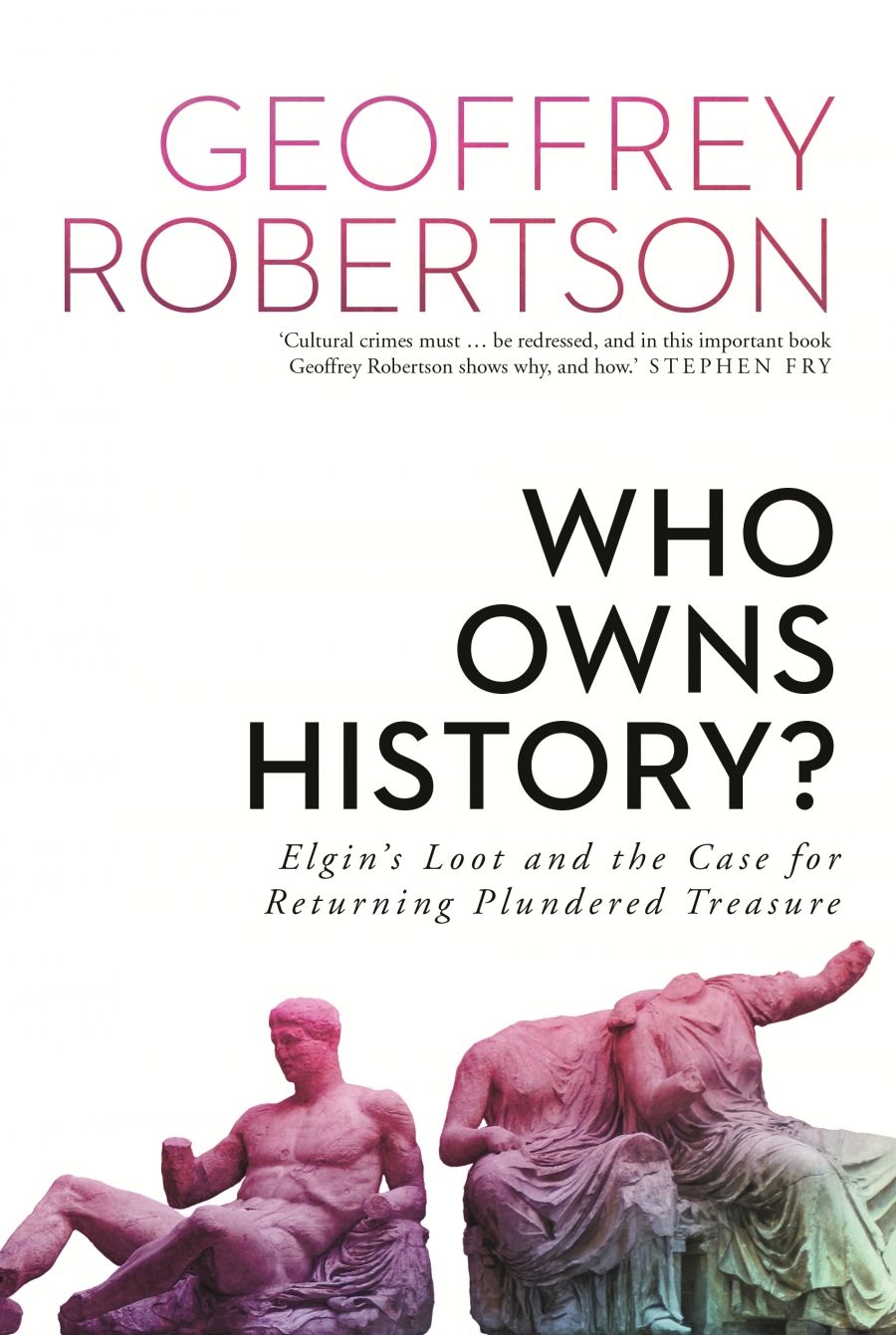
- Free Article: No
- Contents Category: History
- Review Article: Yes
- Custom Highlight Text:
After his success in forcing the British Natural History Museum to return skulls and bones of Tasmanian Aboriginals, the human rights lawyer Geoffrey Robertson was asked by the Greek minister of foreign affairs to ascertain whether international law could be used to induce the British to return the Parthenon Marbles to Greece. Although the project found favour with a succession of Greek prime ministers, the Tsipras government decided not to act on Robertson’s recommendations. This book is a revised version of his report, along with a discussion of demands for the repatriation of other cultural treasures.
- Grid Image (300px * 250px):

- Book 1 Title: Who Owns History?
- Book 1 Subtitle: Elgin’s loot and the case for returning plundered treasure
- Book 1 Biblio: Knopf, $39.99 pb, 304 pp
Many people have argued for the return of the Marbles. Robertson’s main contribution is a survey of legal reasons for repatriation. A UNESCO Convention prohibits the illicit exportation of cultural property, though it only applies to property stolen after 1970. The United Nations General Assembly has passed resolutions favouring repatriation. The International Court of Justice has the authority to provide an opinion on cases that involve a continuing wrong, and human rights law, by supporting the ability of a people to maintain their culture, suggests that they ought to have access to items essential to it. Robertson admits that none of these conventions provides a firm basis for legal action by the Greek government. But he believes that they add up to a ‘ripening’ norm that makes it customary for states to return cultural property to victims of wrongful appropriation. As an example of this trend, he refers to French President Macron’s recent support for the return to Africa of cultural property now in French museums.
Most people now agree that Lord Elgin’s removal of the Marbles from the Parthenon was of doubtful legality. Robertson conclusively establishes Elgin’s guilt. He had no permission from the Ottoman court, only a letter from an official allowing his party to make casts of the Parthenon friezes and to take whatever they could scavenge from the rubble around the building. Elgin’s men stripped figures from the frieze and cut away statues from their niches. ‘The words “vandalism” and “looting” are appropriate descriptions of Elgin’s actions.’
If everything wrongly taken has to be given back, the result would be the mass exodus that museum directors fear. But Robertson is not advocating a wholesale return of items stolen in past centuries. He lists conditions that should be taken into consideration when states make claims for the return of cultural property. They must prove a historical connection to the objects they claim or a spiritual relationship that remains relevant. They must be able to care for them in environments that are optimal for the appreciation of their aesthetic value. They must not have the intention of using them for deceitful propaganda purposes, and they must not be violators of human rights.
 The Parthenon Marbles at the British Museum of History (photograph by Justin Norris/Flickr)
The Parthenon Marbles at the British Museum of History (photograph by Justin Norris/Flickr)
The Marbles rightly belong to the Greeks, Robertson says, because they are the key to Greek history and culture. But what is so special about the Greeks? The art, philosophy, and politics of ancient Athens are integral to Western cultural development. They have probably influenced the art, tastes, ideals, and ways of thinking of present-day British people as much as those of present-day Greeks. We can support the Greeks’ claim to the Marbles and still wonder what it is about their culture and history that gives them a better claim. Robertson provides no answer.
The best reason for repatriation is aesthetic. The Marbles, Robertson points out, are an integral part of the frieze and other sculptures constructed for the Parthenon. They were meant to be seen and appreciated in context, and they would now best be viewed in the gallery that the Greeks have constructed near the Parthenon, where visitors looking through the windows can see how they fit into the artistic scheme for the whole. The sculptures are more likely to work their magic in this place than in a room in the British Museum.
Robertson uses his list of repatriation conditions to discuss other cases. There is good reason, he believes, for returning at least some of the Benin Bronzes taken by the British during a punitive military expedition in Africa, though return should be conditional on the ability of Nigeria to house them safely. The British unjustly looted treasures from the Summer Palace outside Beijing during one of the Opium Wars, but Robertson has doubts about returning them to China because of its record on human rights. The shield appropriated by Captain Cook after an encounter with Aboriginal people on his landing at Botany Bay should be returned to Australia. It has little meaning to the British but special significance to Indigenous and other Australians.
In his discussion of these cases and the factors that ought to be taken into account, Robertson is trying to balance the legal and moral requirements of reparative justice with the imperative to protect aesthetic values; the meaning of cultural objects for people of a nation with cosmopolitan values. How to adjudicate between these requirements needs more discussion, but Robertson’s book is a passionately engaged and well-argued contribution to the Parthenon Marbles controversy and to the issues raised by increasing demands for repatriation of cultural property.


Comments powered by CComment